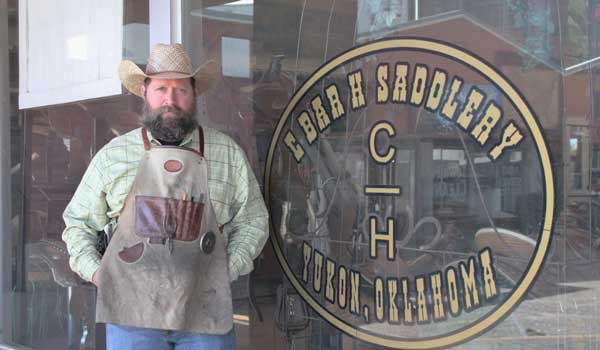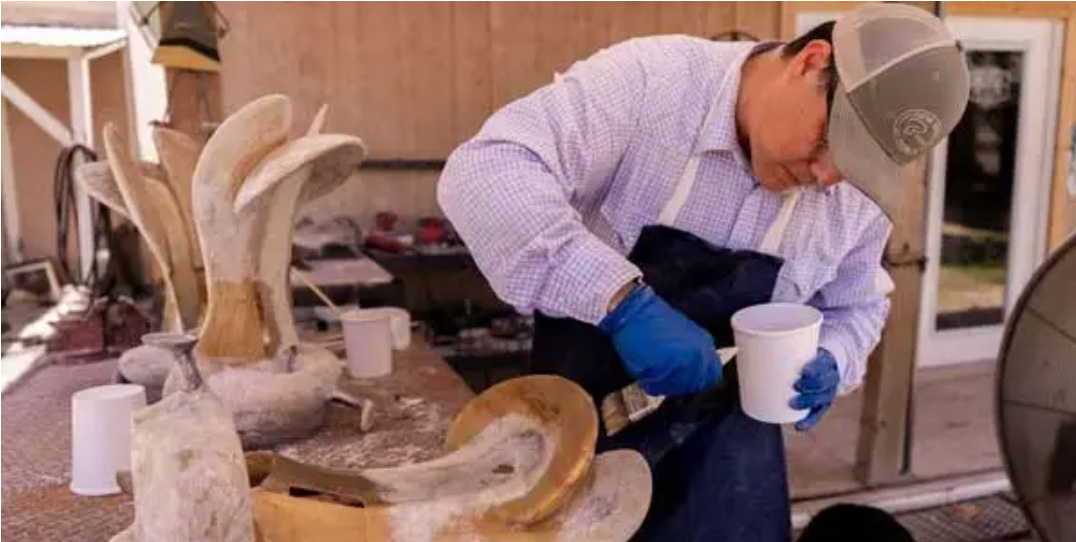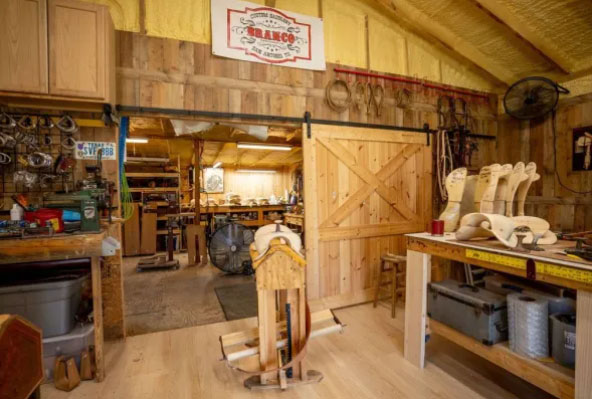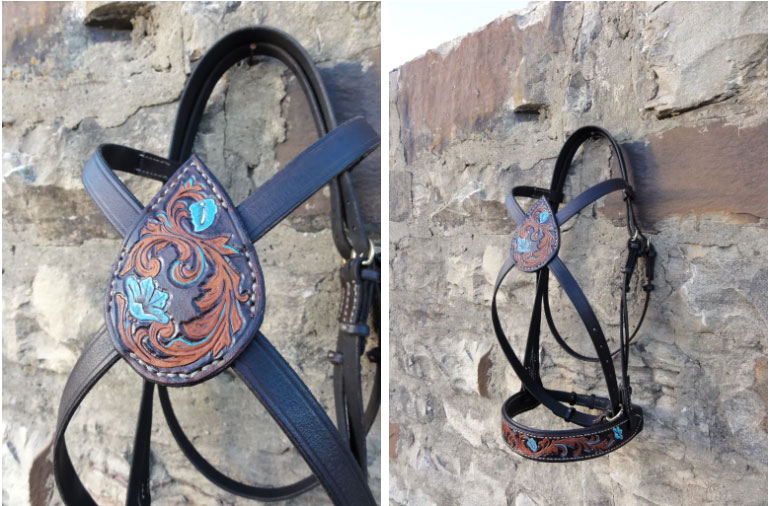Tack & Farm
Our Tack & Farm section features an Apparel section to find both practical and fashionable riding attire. If you ride English & Western or Race, many sources are available in the Tack section.
Building a barn? Need an architect for your equine dream home? Find one in Barns & Stalls.
Have a hungry horse? Of course you do! Find a place to buy your feed and tuck your horse in at night in the Bedding & Feed section. Looking for a place to keep your horse? You can find it in the Horse Boarding section. Keep your horse happy and beautiful with resources in our Grooming section.
Traveling? Find a Shipping company or Horse Sitting service if your horse is staying home!
Running and maintaining a farm or stable is a continuous effort, and to help find products or tools you need, please see our Equipment, Fencing and Management Tools sections.
Seeking Services? Find financial and tax expertise in our Accounting section. Companies who will help protect your investment are found in the Insurance section. For those who want legal advice about purchasing, liability, and other issues, please look at the Equine Law section to find an expert. Build and promote your business with teams from Marketing / Videography / Web Design.
Do we need to add more? Please use the useful feedback link and let us know!

by Nick Pernokas
The June heat came off the tarmac in shimmery waves outside the cattle pens at the Oklahoma City stockyards. It was just another sale day, and the cowboy enjoyed moving the cattle up the alleys on horseback after they were sold. It was just a part-time job, but it let him get out and do a little cowboying. When his sweaty mare tired, the cowboy borrowed another mount. He changed the saddle over to the gelding at his stock trailer. Both horses were tied next to each other and the cowboy ducked under the gelding’s neck to adjust his breast collar. In the slow-motion unfolding of events that is familiar to any horseman that’s been in the wrong place at the wrong time, the gelding set back. The lead rope was stretched taut from horse trailer to sitting horse, almost to the breaking point. Almost. The horse rebounded up the lead with both feet in the air in front of him. One foot caught the cowboy over his left eye, breaking his neck. He was able to roll under the trailer and push himself with his feet to the back of the trailer.
“I couldn’t feel my arms or my legs,” remembers Clinton Hole.
Unable to see out of his blood-filled left eye, Clinton laid on the ground and shouted weakly for help. A truck driver, who was filling out paperwork in the parking lot, heard him and came to his aid.
Clinton’s father, Rollin, was a pastor. Originally from Indiana, Rollin traveled the rural areas of Kansas and Oklahoma. Many times, Clinton rode along with him and this gave him his first taste of the farming and ranching community.
When Clinton got out of high school in Newton, Kansas, in 1991, he discovered the world of bull riding. Clinton competed in regional associations like the Central Plains Rodeo Association. Clinton earned his nickname, “Doc,” on the rodeo circuit because he bore a resemblance to Doc Holliday in the film Tombstone. Between buck outs and rodeos, Clinton realized he enjoyed fixing gear for his fellow bull riders.
Clinton began hanging around at a local horse trainer’s place. The trainer trained western pleasure horses so Clinton was exposed to a new discipline. Clinton volunteered to chip in with the chores and in return he was given a few lessons. He also began to develop more of an appreciation for saddles.
Clinton rode bulls for about eight years. By now, he had a commercial truck driving license and was driving for a local company during the week and rodeoing on the weekends. In 1998, Clinton decided to quit a job driving heavy equipment and go to horse shoeing school in Purcell, Oklahoma. Clinton liked Oklahoma so when he hung out his shingle as a horse shoer, he moved to Kingfisher, Oklahoma, where his dad was living. He also began starting a few horses. One of these was a nice mare that a friend had given him. Clinton got her used to guns because he wanted to be able to take her hunting. A chance invitation to a mounted shooting practice proved that Clinton’s training was sound. The mare took to the pair of 45’s being fired off her back immediately. Soon Clinton was successfully competing in mounted shooting competitions. In 2004, he was the Oklahoma Men’s State Champion in mounted shooting. A national and world championship soon followed.

In 2005, Clinton was shoeing horses in Bethany, Oklahoma, at the Southern Nazarene University. He began dating Mindy, who was one of the managers of the horse program there. Mindy had started out riding English and jumping. At SNU she coached the Intercollegiate Horse Show Association team.
In 2006, they were married. Clinton started doing a little leather tooling with some old Tandy tools. He also repaired a few saddles.
“I rode my share of junk early on and started learning what was good and what wasn’t.”
In 2007, Clinton decided that he’d like to learn how to build a saddle. He searched on the internet for a school that would fit in with his horseshoeing schedule. Don Atkinson, a saddlemaker in Kerrville, Texas, offered a two- or three-week course where a student could build a saddle. After an hour-long phone conversation, the two men clicked. Clinton headed to Kerrville.
“Walking into his shop was like walking back in time,” remembers Clinton.
Within three weeks, under Don’s guidance, Clinton had built his first saddle and had worked on his tooling as well.

by Nick Pernokas
Brandit Franco grew up in the heart of Florida’s cowboy country. The family business was starting colts and training ranch horses. Brandit’s father, Sam Franco, took a lot of horses to ride that weren’t making it in someone else’s training program. Sam trained everything from Quarter Horses to wild Mustangs in the Seventies and Eighties. Brandit grew up working cows in southern Florida, around Okeechobee and Kissimmee, which is a different type of cowboying then most people visualize in the American West.
 />
/>
“I was born into it,” remembers a 47-year-old Brandit. “I cut my teeth dragging cattle out of the swamps.”
A lot of Brandit’s youth was spent in north central Florida. Sam was an ex-military man though and he was a wanderer. He trained horses all of his life, but he would move from one horse training job to another.
“He followed where his heart told him the horse business was,” says Brandit.
Brandit helped his dad with the horses and learned to ride and break them. Like many cowboys, Sam knew how to fix a saddle and tack when it was necessary.
“We weren’t rich folks by any means so we had to do our own leatherwork.”
Brandit’s first job in leatherwork was setting rivets for his dad. Brandit eventually built a few saddles with Sam, but they were pretty plain, working saddles.
The Franco family moved from Florida to the Mineral Wells, Texas area in the mid Eighties. They were only there for a few years, but Sam was friends with famed all-around cowboy Ed Workman. Ed trained horses at his indoor arena just outside of town and Brandit was able to learn how to rope calves from him. But, Brandit’s first love was competing in the saddle bronc and bareback bronc riding events and the roping never replaced that.
Brandit’s family moved to New Mexico in 1993, which was his final year in high school. As a senior, he rode bareback broncs at the high school rodeos, but a back injury forced him to hang up his rigging for good after that. After that, Brandit’s bronc riding was limited to the horse training kind.
“My dad said that if I wanted to ride broncs, I didn’t have to do it for a buckle. He had plenty for me to ride right at the house.”
In 1994, the family made their final move to San Antonio, Texas. Sam kept training outside horses and he also had a small leather repair shop.

by Gene Fowler
As I sat wondrously immersed in the universe of the television program Yellowstone during its recently concluded fourth season—the hats, the horses, ranchers, cowboys, pretty women, gorgeous country, and a lone guitar—the notion that folks might have been savoring the same scenery on the other side of the world was the farthest thing from my mind.
The Republic of South Africa, for instance. Like many, if not most, Americans, my awareness of the nation on the southern tip of the African continent was so limited that it might as well have been on Mars. Then Shop Talk! asked me to write about the young South African leathercraft artist Arran Wood, who Instagram’s his beautiful and unique creations of equine tack with the handle @woodenwulf.
And when I asked Arran to tell me a little about his life in the former Dutch and British colony, he mentioned that Yellowstone is one of his favorite TV shows. And even more than the sumptuous landscape of the American West and the regional intrigue that dramatizes the collision of interests of a longtime ranching family, developers, politicians, Native Americans, and a bunkhouse full of colorful buckaroos, it’s the horse culture that captures Arran’s eye.
The twenty-three-year-old South African spent his first ten years in the urban environment of Cape Town, population 4.6 million-plus. “My family moved to a horse and cattle farm about twelve years ago,” he says. “Over the years I grew to know horses and their nature…. Slowly, over time I became a better rider through cattle herding and endurance riding. Then about four and a half years ago I saw some very interesting tack and bridle styles on Instagram.”
Living in South Africa, he continues, “it’s difficult to buy things from overseas, so I was inspired to make my own. I’ve always had a keen interest in making things with my hands, and after making my first bridle I realized there’s a market for this style of tack. So, I set about to create that for people.”

Arran says he learned leatherwork through trial and error, taking up the artform about the same time as his dad. “My whole family is creative. My mom spins her own wool from our sheep and does a lot of weaving. She also runs an outreach program called Hopeknitters. And my sister is a photographer; her business is Paigewoodphotography. My father studied fashion design and worked in that field for some time, then moved into designing buildings instead of clothes. He is also a skilled carpenter and does his own leatherwork, although it’s very different from my own. He makes and sells gun holsters and belts under the brand Arctic Wolf Gear. He taught me some leatherwork techniques, but we sort of picked up the trade at the same time and learned together.”
Arran reports that leatherworking tools are difficult to find in South Africa and expensive when you do find them. “There are a couple shops in the major cities and one or two good online stores. But I’m careful to maintain my equipment, keep my tools sharpened and oil them well, so they last a long time. In terms of the leatherworking craft in my country, I think there is a massive lack of skilled professionals who genuinely care about their work. You can find plenty of leather products, but there doesn’t seem to be much skill in the works. We suffer from a very large amount of unskilled labor, and we lack the professionals to teach these skills and hand them on. But at the same time, you’ll find some small businesses doing incredible work with leather. Our handcrafted leather shoe businesses are especially strong.”
Read more: Big-Small World of Leathercraft, South African Edition

by Nikki Alvin-Smith for Horizon Structures
The minefield of decisions to be made for new horse housing and pasture set-ups can be difficult to navigate, especially if the move is to a new farm a significant distance away or one in a different climate.
Moving horse and home can be a challenging event even for the best organized horse property owner. The decision to relocate can present many challlenges that have to be addressed to facilitate the move successfully. Problems such as timeline management for vacating a ‘Sold’ property and closing on the new one, readiness of the new site for horse occupation and renovations or modificationss required to provide adequate housing for the incoming equine residents.
The minefield of decisions to be made for new horse housing and pasture set-ups can be difficult to navigate, especially if the move is to a new farm a significant distance away or one in a different climate.
Regional and local moving companies will take care of all the ‘stuff’ associated with our households. But the acquisition of a new horse farm, especially one ready for development where horses will need to be stabled or sheltered pending construction of a barn requires some savvy planning.
The Zero Turn Horse Farm
If you are doing a 180 degree turn and migrating from boarding your horse(s) to development of a parcel of land that may include a home but has little to offer in the way of barns or storage structures then closing on the property will be just the beginning of a long and arduous journey toward making your horse farm dream a reality that you can sit back and enjoy from the saddle.
Even if you are blessed with unlimited funds and can employ experienced construction crews to build your new barn, there will be many decisions to be made. Try to choose a company that has experience and talented craftsman not just to build the structure, but also to work with you in a positive ‘old-fashioned’ customer service manner throughout the process.
More likely budget constraints will demand some entrepreneurial and enterprising ideas and adjustments to the final development plan. Often, as you live with a property, you find even the best laid plans change as you develop a sense of the perspective of living in the new environment and appreciate the diversity of the land you have acquired.
Have Barn Will Travel
A simple ‘starter’ shelter that is budget-friendly will be a simple run-in shed within a well-fenced paddock. If the run-in shed is modular in design, planning permission for its siting may not even be required as long as zoning set back distances are honored.

Prefabricated run-in sheds offer another significant advantage: mobility. Large metal tow hooks installed at the corners of the structure facilitate hauling the building from Point A to Point B utilizing a pick-up, tractor or UTV.
Read more: Overcoming The Challenges of Moving Horse and Home
- DND Leather – Where Beauty and Function Come Together
- Tanner Custom Leather
- Why Do Horses Wear Turnout Rugs?
- Horizon Structures Presents Series: Making Sense of Barn Building Plans
- Horizon Structures Presents Series: Is Your Horse Barn Wearing the Right Hat?
- The Not-So-Great Indoors
- Seeking a New Spot for Your Horse? Need and Overnight Horse Motel? Look No Further, We've Got This!
- Horse Boarding - Checklist!
- The Cowboy Leathercrafter
- What Kind of Saddle Pad Is Best for Your Horse?
































